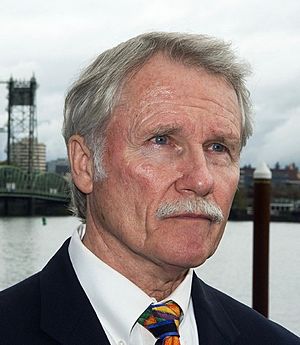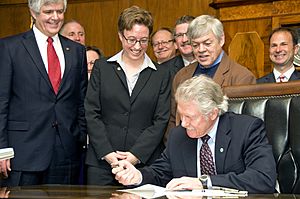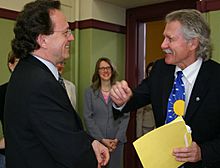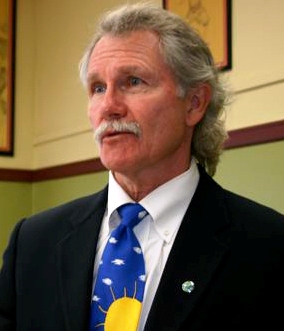John Kitzhaber facts for kids
Quick facts for kids
John Kitzhaber
|
|
|---|---|
 |
|
| 35th & 37th Governor of Oregon | |
| In office January 10, 2011 – February 18, 2015 |
|
| Preceded by | Ted Kulongoski |
| Succeeded by | Kate Brown |
| In office January 9, 1995 – January 13, 2003 |
|
| Preceded by | Barbara Roberts |
| Succeeded by | Ted Kulongoski |
| President of the Oregon Senate | |
| In office January 3, 1985 – January 3, 1993 |
|
| Preceded by | Edward Fadeley |
| Succeeded by | Bill Bradbury |
| Member of the Oregon Senate from the 23rd district |
|
| In office January 12, 1981 – January 3, 1993 |
|
| Preceded by | Jason Boe |
| Succeeded by | Rod Johnson |
| Member of the Oregon House of Representatives from the 45th district |
|
| In office January 8, 1979 – January 12, 1981 |
|
| Preceded by | Al Shaw |
| Succeeded by | Verner Anderson |
| Personal details | |
| Born |
John Albert Kitzhaber
March 5, 1947 Colfax, Washington, U.S. |
| Political party | Democratic |
| Spouses |
Rosemary Linehan
(m. 1971; div. 1974)Sharon LaCroix
(m. 1995; div. 2003) |
| Domestic partner | Cylvia Hayes (2003–present) |
| Education | Dartmouth College (BA) Oregon Health & Science University (MD) |
John Albert Kitzhaber (born March 5, 1947) is an American former politician and doctor. He served as the governor of Oregon two separate times. His first time was from 1995 to 2003, and then again from 2011 to 2015. He is a member of the Democratic Party. Kitzhaber served longer as governor than anyone else in Oregon's history.
In February 2015, he stepped down from his role as governor. Kate Brown, who was the Secretary of State, took over as governor.
Contents
Early Life and Education
John Kitzhaber was born on March 5, 1947, in Colfax, Washington. He finished high school at South Eugene High School in 1965. He then went to Dartmouth College and earned a degree in 1969. In 1973, he received his medical degree from Oregon Health & Science University.
From 1973 to 1986, Kitzhaber worked as an emergency doctor in Roseburg, Oregon.
Starting a Political Career
John Kitzhaber began his journey in politics in 1978. He was elected to the Oregon House of Representatives, where he served for one term.
In 1980, he was elected to the Oregon State Senate. He served there for three terms, from 1981 to 1993. During this time, he became the president of the Senate, a role he held from 1985 to 1993. As Senate President, he played a key role in creating the Oregon Health Plan. This was a state-funded health care plan for Oregon residents.
Serving as Governor
First Time as Governor: 1995–1999
In 1994, Kitzhaber became the Democratic candidate for governor. The current governor, Barbara Roberts, decided not to run again.
Kitzhaber won the election in November 1994 with 51% of the votes. He was sworn into office on January 9, 1995.
During his first term, Governor Kitzhaber started the Oregon Children's Plan. This plan aimed to help children and families who were facing difficulties.
Second Time as Governor: 1999–2003
In 1998, Kitzhaber ran for governor again. He won the election with 64% of the votes. He won in 35 out of Oregon's 36 counties.
During his second term, Kitzhaber focused on protecting natural resources. He created The Oregon Plan for Salmon and Watersheds. This plan worked to help bring back the number of threatened salmon in Oregon's rivers. It encouraged different government groups and private landowners to work together. Kitzhaber also supported protecting Oregon's land and managing growth, especially in the Willamette Valley.
According to Oregon's rules, Kitzhaber could not run for a third term right away in 2002. Ted Kulongoski, another Democrat, became the next governor.
Time Away from Governorship: 2003–2011
After his first time as governor, Kitzhaber continued to work in health care. He became the director of the Center for Evidence Based Policy at Oregon Health & Science University. He also led other health care organizations and started a group called the Archimedes Movement. This group focused on improving health care for everyone.
Third Time as Governor: 2011–2015
In September 2009, Kitzhaber announced he would run for governor again. He won the Democratic primary election in May 2010.
In the main election, he ran against Chris Dudley. Kitzhaber won a close election. He was sworn in for his third term on January 10, 2011.
In 2011, Kitzhaber announced that he would not allow any executions to happen in Oregon while he was governor. He believed the system for death sentences was unfair. The Oregon Supreme Court supported his decision in 2013.
During this term, there were challenges with the launch of Cover Oregon. This was a website for health insurance. Kitzhaber also faced questions about his fiancée, Cylvia Hayes, and her consulting work.
Fourth Time as Governor: 2015
Kitzhaber ran for reelection in 2014 and won. He started his fourth term as governor on January 12, 2015. This made him the longest-serving governor in Oregon's history.
He said this term would be his last. He wanted to focus on reducing inequality in Oregon. However, he stepped down from office on February 18, 2015. Kate Brown became the new governor.
Life After Governorship
John Kitzhaber continues to work in health care policy. He is the director of the Center for Evidence Based Policy at Oregon Health & Science University. He also holds a special position at The Foundation for Medical Excellence. This foundation creates educational programs for doctors. Kitzhaber is also the president of the Estes Park Institute. This group helps health care leaders and hospital executives learn more.
In 2006, Kitzhaber announced the Archimedes Movement. This group aims to create a health care system that helps everyone. They want to make sure everyone has access to good health services.
Personal Life
John Kitzhaber has a son named Logan. He lives with his fiancée, Cylvia Hayes. They announced their engagement in 2014.
During his time in politics, Kitzhaber became known for wearing blue jeans to events. He even wore jeans to his inauguration in 1995, which was unusual for a governor. He also often chose not to wear a necktie.
Kitzhaber lives and works in Portland. He chose not to live in the official governor's residence, Mahonia Hall, in Salem while he was governor.
See also
 In Spanish: John Kitzhaber para niños
In Spanish: John Kitzhaber para niños





